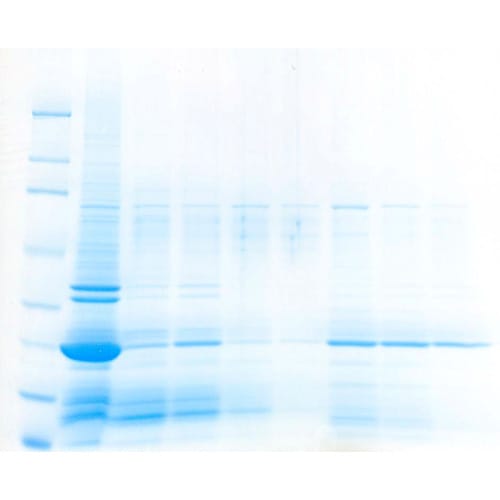In 1975, Porath developed Immobilized Metal Affinity Chromatography (IMAC). It is based on the interaction of specific protein residues, including histidines, cysteines, and occasionally, tryptophans, with cations of transition metals.
The Ni-NTA Agarose Resin is designed for the purification of recombinant proteins fused to the histidine (6XHis) tag in bacteria, insects, and mammalian cells.
What is Ni-NTA Resin?
Ni-NTA Agarose is a high-binding, high-capacity nickel charged IMAC resin that purifies recombinant proteins with the polyhistidine (6XHis) sequence. Proteins bound to the resin may be eluted with either low pH buffer or by competition with imidazole or histidine.
Ni-NTA Agarose Resin utilizes the tetradentate chelating ligand nitrilotriacetic acid (NTA). The NTA is coupled to a cross-linked 6% agarose resin that is suitable for batch and gravy flow applications. The NTA also binds Ni2+ ions by four coordination sites.
The resin is a 6% cross-linked agarose for structural integrity with a high capacity of 20-40μmoles Ni2+/ml resin. It results in a high protein binding capacity or >50mg protein per ml resin.
How to Regenerate Ni-NTA Resin to Extend Its Life
When regenerating Ni-NTA Agarose Resin, you should perform regeneration when a considerable diminution in the field is observed. The frequency of the following stages varies with the proteins and conditions:
- Wash Ni-NTA Agarose resins with five volumes of a buffer that strips the metal ions from the agarose, we recommend 20mM sodium phosphate
supplemented with 0.5M NaCl, 50mM EDTA at pH 7.0 - Wash the agarose with five volumes of deionized water to remove the metal chelator, EDTA.
- To eliminate ionic interactions, wash in batch for approximately 20 minutes in a solution with 1.5M NaCl. Wash the resin with 10 column volumes of distilled water to remove ions.
- To eliminate precipitated proteins, wash in batch for at least two hours with a solution 1.0M NaOH. Eliminate NaOH with 10 column volumes of distilled water.
- To eliminate strong hydrophobic interactions, resuspend the resin in batch with a solution of isopropanol 30% for approximately 20 minutes. Wash the resin with 10 column volumes of distilled water to eliminate the isopropanol.
- To eliminate lipids, wash in batch for two hours with a solution 0.5% of non-ionic detergent in 0.1 M acetic acid. Rinse the detergent with ethanol 70% (approximately 10 column volumes).
- Wash the resin with 10 column volumes of distilled water to rinse out the ethanol.
- To recharge the agarose with Ni2+, wash with five volumes 0.1M NiSO4 x 6 H20.
- Wash and remove excess metal ions with five volumes of deionized water.
- Prepare the column by adding 5 column volumes of the binding buffer.
Tips for Using Ni-NTA Resin
- Ni-NTA Agarose Resin is shipped at ambient temperature. Upon arrival, store Ni-NTA Resin at 4 C.
- Ni-NTA should be refrigerated and not stored in a freezer. .
- The yield and purity of the recombinant fusion protein depend on the protein's conformation, solubility, and expression levels. You should optimize and perform small scale preparations to estimate expression and solubility levels.
- Avoid EDTA containing protease inhibitor cocktails, we recommend our Recom ProteaseArrest™ for inhibiting proteases during the purification of recombinant proteins.
- For recombinant proteins that are sequestered to inclusion bodies, we recommend our IBS™ Buffer.
Choose G-Biosciences for Your Ni-NTA Resin Essentials
G-Biosciences offers a variety of products and supplies for your life science experiments, including research-grade Ni-NTA Agarose Resin. Visit our website to claim yours today!






